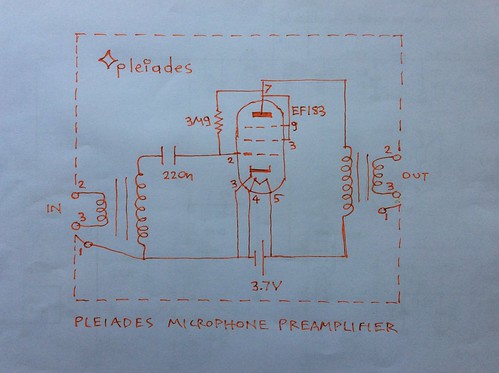It is early to say.
This is a hypothesis. The grid to anode external Pleiades bias resistor removes many of the electrons that may cause grid noise out of the electron tube, out of the cathode grid circuit. They go externally directly to the anode. (The Pleiades bias resistor can also be connected to Vb or any other positive potential source).

Pleiades V6 schematic, Cc=22nF, Pleiadss Bias Rag=6MΩ, Nuvistor 7586 electron tube can substitute EF183
On Techniques and Applications of Electron Tubes in Military Ewuipment, page 1-14, at least 4 sources of grid current are identified.
a. Electrons of high initial velocity. (This seems to be what is described in previous euroelectron posts as what happens when just heater voltage is applied to an electron tube. Electrons emmited from cathode leave it positive or make the grid negative. By closing an external circuit between cathode and grid electrons are transported out of the grid and back to cathode. Pleiades bias externally couteracts this internal bias mechanism so that the electron tube can operates with a very low plate or anode voltage.)
b. Ions formed by collisions.
c. Interelemnt conductive paths (surface leakage).
d. Undesired electron emission (from elements other than the cathode).
The hypothesis is that the Pleiades resistor takes many of these electrons out of the electron tube and away from the cathode grid circuit.
Furthermore since the electron tube can now operate at very low anode voltage, the heater voltage can be reduced too for same space charge conditions [Pearson], [Llewellyn]. A low cathode temperature makes the other electrodes less hot too thereby minimising some of the above effects.
Space charge conditions may make this external grid to anode current be free of shot noise.
So far the experimental evidence that the Pleiades V6 is a very low noise circuit is listening microphone tests comparing with other electron tube or JFET, bipolar preamplifiers. Some of them of the highest quality.
The fact that even a very low output Grampian ribbon microphone can sound very big and of a high s/n.
Also the fact that short circuiting from ground or cathode to the input coupling capacitor makes the noise at the output almost disappear in a dramatic way.
More experiments are needed and of course building the Pleiades V6 hardwired.
The increase of input resistance test can be done then until the value of output noise is double the short circuit noise. This would give the equivalent noise resistance. [Pearson]
References:
Techniques for application of electron tubes in military equipment - WADC TR 55-1
http://www.dtic.mil/dtic/tr/fulltext/u2/142061.pdf
Fluctuation Noise in Vacuum Tubes - G. L. Pearson - (can be found on archive.org)
A study of Noise in Vacuum Tubes and Attached Circuits - F. B. llewellyn
No comments:
Post a Comment